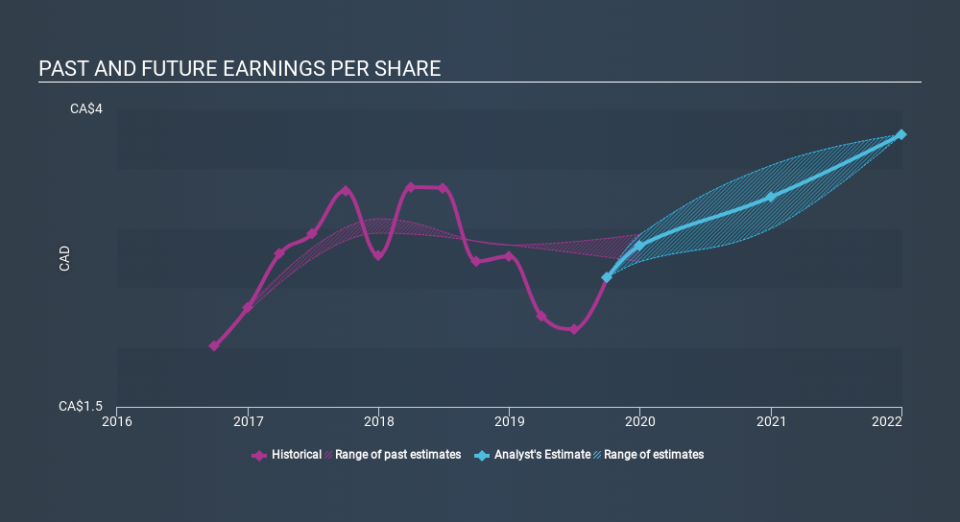Did You Manage To Avoid Power Corporation of Canada's (TSE:POW) 29% Share Price Drop?

Ideally, your overall portfolio should beat the market average. But every investor is virtually certain to have both over-performing and under-performing stocks. At this point some shareholders may be questioning their investment in Power Corporation of Canada (TSE:POW), since the last five years saw the share price fall 29%. It's down 29% in about a month. We do note, however, that the broader market is down 24% in that period, and this may have weighed on the share price.
View our latest analysis for Power Corporation of Canada
To quote Buffett, 'Ships will sail around the world but the Flat Earth Society will flourish. There will continue to be wide discrepancies between price and value in the marketplace...' One flawed but reasonable way to assess how sentiment around a company has changed is to compare the earnings per share (EPS) with the share price.
Looking back five years, both Power Corporation of Canada's share price and EPS declined; the latter at a rate of 0.2% per year. This reduction in EPS is less than the 6.5% annual reduction in the share price. This implies that the market is more cautious about the business these days. The low P/E ratio of 9.40 further reflects this reticence.
You can see below how EPS has changed over time (discover the exact values by clicking on the image).
We're pleased to report that the CEO is remunerated more modestly than most CEOs at similarly capitalized companies. It's always worth keeping an eye on CEO pay, but a more important question is whether the company will grow earnings throughout the years. Before buying or selling a stock, we always recommend a close examination of historic growth trends, available here..
What About Dividends?
When looking at investment returns, it is important to consider the difference between total shareholder return (TSR) and share price return. The TSR is a return calculation that accounts for the value of cash dividends (assuming that any dividend received was reinvested) and the calculated value of any discounted capital raisings and spin-offs. Arguably, the TSR gives a more comprehensive picture of the return generated by a stock. We note that for Power Corporation of Canada the TSR over the last 5 years was -9.0%, which is better than the share price return mentioned above. The dividends paid by the company have thusly boosted the total shareholder return.
A Different Perspective
While it's never nice to take a loss, Power Corporation of Canada shareholders can take comfort that , including dividends, their trailing twelve month loss of 13% wasn't as bad as the market loss of around 18%. Unfortunately, last year's performance may indicate unresolved challenges, given that it's worse than the annualised loss of 1.9% over the last half decade. Whilst Baron Rothschild does tell the investor "buy when there's blood in the streets, even if the blood is your own", buyers would need to examine the data carefully to be comfortable that the business itself is sound. It's always interesting to track share price performance over the longer term. But to understand Power Corporation of Canada better, we need to consider many other factors. To that end, you should be aware of the 1 warning sign we've spotted with Power Corporation of Canada .
But note: Power Corporation of Canada may not be the best stock to buy. So take a peek at this free list of interesting companies with past earnings growth (and further growth forecast).
Please note, the market returns quoted in this article reflect the market weighted average returns of stocks that currently trade on CA exchanges.
If you spot an error that warrants correction, please contact the editor at editorial-team@simplywallst.com. This article by Simply Wall St is general in nature. It does not constitute a recommendation to buy or sell any stock, and does not take account of your objectives, or your financial situation. Simply Wall St has no position in the stocks mentioned.
We aim to bring you long-term focused research analysis driven by fundamental data. Note that our analysis may not factor in the latest price-sensitive company announcements or qualitative material. Thank you for reading.

 Yahoo Finance
Yahoo Finance 
